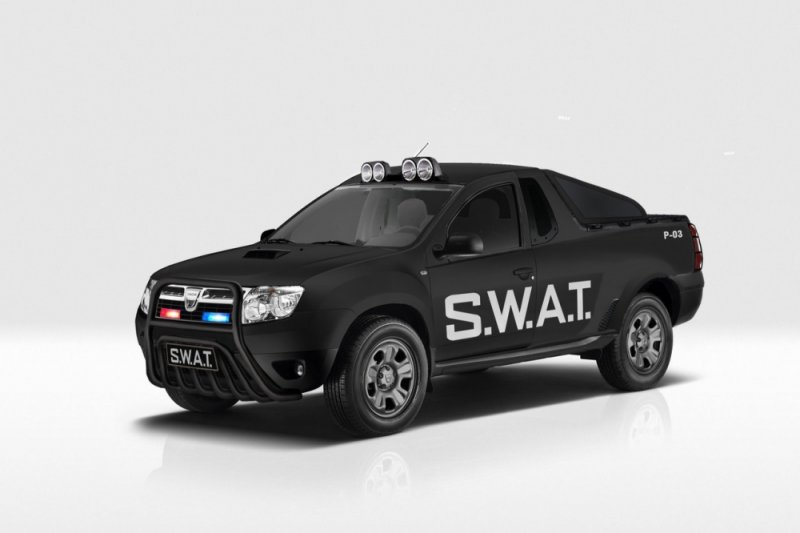Absolute space and comfort is the first thing that Renault Duster is appreciated for by whoever sits inside. The doors open reasonably wide enough and have specific halt positions. I.e. You can rigidly halt the doors at certain angles without allowing them to slip. As I mentioned earlier, the car is marginally taller than regular tall-boy hatchbacks but getting into it is as much convenient for kids and elders alike, eliminating the requirement of a dedicated footboard. Ingress and egress is a breeze for front occupants, though since the foot well for rear passengers is ahead of the door, they have to pull back and lift the foot in order to step outside. It might increase inconvenience for passengers who’re above 5’11”. The ‘thud’ of doors may not be equivalent to that of Germans but is satisfying to provide a sense of sturdiness in Duster.
Great part about driving an SUV is ‘king of the road’ feel and this car ticks that box. The seating position provides a pleasant view of the corners as well as of the road. In fact, I got so used to of this seat height that I felt too low-slung upon driving my Fiesta after three days. The dashboard layout is functional and well-laid out with better part being that it doesn’t reflect too much on the windshield. There’s a separate layer of beige tone in middle of dashboard to harmonize Duster’s beige and piano black interior theme.
Steering wheel is on a somewhat heavier side but offers a sound grip. European format stalks (Headlamp on left and wiper functions on right) work with a gentle touch. A quick pull of the wiper stalk deploys the windscreen washer with one sweep while a longer pull does the same but thrice. In the beginning I was tapping the button on tip of wiper’s stalk to activate washer but alas, nothing worked. I tapped it a couple of times again and eventually figured out that it operates the modes of multi-information screen on front. It could be confusing for new owners too because this button is not marked.
The simplistic design form is evident in the instrument cluster too. There’s an unfussy tachometer and speedometer along with multi-information screen situated in the center. Renault is using the same template as on Duster 4x4 (Not launched in India) for the instrument cluster as I could observe a dummy ‘4WD Lock’ and ‘2WD’ icons on it. Additionally, it is difficult to distinguish whether the instrument cluster icons are lit or not under direct sunlight (Particularly indicators).
The multi-information screen is a useful tool enlightening the user of basic details which include: fuel gauge, engine temperature levels, odometer as well as time. Pressing the pin on instrument cluster offers an option to view or reset trip meter or just update the time. Tapping on the button I was talking about earlier offers to choose between the following modes: Average speed, distance to empty, fuel efficiency and liters of fuel consumed. A unique bit is the steering mounted control that operates audio system and Bluetooth supported phone controls. However, the real catch is that they’re not mounted ‘on’ the steering but behind one. It’s an individual device with a set of buttons to adjust volume, flip between audio modes and to receive or cancel the calls.
The bottom of dashboard is comprised of average plastic quality with a few cheap-to-look parts. Take beam adjustment rotary knob for example. Firstly, the numbers are not noticeable because of being imprinted on the plastic itself. Secondly, why this knob is placed so low is beyond me. Similarly, the hood opening lever is unmarked and camouflages like some part of dashboard. The circular air conditioner vents shut and lock with a mild click and are valuable in providing a precise throw of air unlike traditional vents. I should, however, admit that the air conditioner took its own sweet time to cool the cabin but once it does, it does efficiently. The fan is super silent on speed one though it becomes noisy at speed four. Quite surprisingly, rear air conditioner was as noisier at second speed as the front air conditioner is at third or fourth speed level.
Missing automatic climate control feature in a car that costs over a million is sheer disappointment. On the middle of dashboard – You will notice the usual controls that activate heater, air conditioner, air flow positions and air re-circulation option. The head unit is compatible with CD, USB and plays your favorite radio station too. Further it supports pairing mobile phones equipped with Bluetooth technology to make or receive calls. Some may mistake the center knob for volume adjustment, just as I did but that’s not the case. The head unit has separate buttons to adjust volume and the knob serves for surfing through the settings. Audio setup has total four speakers which are adequate for casual listeners but average for audiophiles. I’m no audiophile either but I discovered the sound quality getting rough as I increased the volume. Apart from the common settings (Bass, Treble, Balance, Bluetooth etc), the head unit has an option for switching between languages with French topping the list for an obvious reason.
What’s more in the center console are buttons for central locking, demister (applies to rear windshield and outside rear view mirrors simultaneously), hazard warning lamp button (blinks in sync with indicators), seat belt and passenger airbag deactivation warning icons. The seat belt icon lights up if the driver does not wear the seatbelt. It’s also supposed to sound a ‘beep’ but that didn’t occur during our test. There’s a vacant space for two buttons, next to parking sensor switch, reserved for Duster 4x4 (For 4x4 mode and ESP). Duster’s hand brake lever has a long play but Renault has a justified reason doing so as they knew they’re leaving the driver in misery by placing outside rear view mirror adjustment joystick button beneath.
Glove box compartment is designed to soak A4 size documents. It’s deep and wide enough and contains separate slot for storing the ownership manual. There’s a lamp in the compartment too but it functions only when the parking lamps are switched on. It’s strongly recommended not to store liquid substances in there as they could damage the OBD (On-board diagnostics) port located deep inside the glove box. The cabin has plenty of cubbyholes along with a band attached on co-driver side of center console to hold a bottle.
The entire vehicle has a spacious feel and lower window positioning further aids to a clear all-around visibility. The front seats are comfortable and well-contoured. In fact, driver’s seat is also privileged with lumbar and height adjustment options. Although the adjustments are smooth to use but the driver needs to move up from the seat in order to increase its height. Moreover, front seats do not have a deep footwell to stretch your legs (if there’s a long passenger sitting behind) but yet they offer a manageable legroom.
Something that I missed on long drives in Duster was a front center armrest. It’s good-to-have feature but certainly not a deal breaker. The doors are fairly solid with a neat piano black finish that extends up to the handles. While the front doors pockets are suitable for storing magazines, it doesn’t have separately sculpted contours for bottles. I was able to keep 500ML water bottle without a fuss but 600ML was a squeeze. It’s also important to note that pockets on rear doors do not exist at all. Just like most of the buttons on Duster, power window switches are smooth to use and work with soft fingers.
Contrarily, the door lock pins are rough and demand reasonable amount of efforts. Locking the driver’s door manually with lock pin does not engage central locking but on the other hand, central locking (through dedicated button) is applied even if one of the doors is left open. More amusingly, one doesn’t need to lift door lock pin to open the front doors. Just pull the chrome latch and it happens automatically. This exact feature is not replicated on rear doors for safety concerns for young ones. Of course, there is child lock too for additional protection. Since the ‘hatch’ is counted as a door, there’s no separate switch for locking or unlocking the boot. Thus, its functioning is in line with central locking.
Until I didn’t experience the rear, I was in a fallacy that driver’s seat is most comfortable to be in Duster but sitting down on rear seat cleared the air. This area is relatively more comfortable and roomier. Believe it or not, the rear center armrest is soft enough to act like a pillow. One of my passengers actually used it as cushion for a quick nap during long drive. The rear seats although are meant to accommodate three occupants in comfort but the rear air conditioner assembly awfully obstructs the legroom unless one is prepared to keep a leg on one side each. Overall, legroom is adequate unless the front seats are fully pushed backward. Renault has attempted to smartly make the most by incurving the front seat’s backrest to allow additional leg space. The rear air conditioner has maximum two speed levels for fan and only a single vent translating that rear seat occupants have to fight initially for positioning of the vent because the unit doesn’t cools instantly.
Contrasting to the front power window buttons which are placed more sensibly on a separate podium, the rear power window buttons are stuck right in the middle of door armrests. It several times caused power windows to open inadvertently due to elbow of the passengers while travelling on rugged terrain. Only if 475 liters of boot space does not suffice – You can fold the rear seat forward in order to access a massive cargo area of 1064 liters. Apart from 12V socket (accessible to rear occupants) and boot lamp, the cargo area has hooks to tie up the luggage. Note that spare wheel is an alloy but it sits under the car (Not in the boot). However, there’s a compartment in the boot itself storing the essential tool kit, which astonishingly skips a warning triangle.
I’m afraid; the toolkit cover flap is made up of low-cost plastic and may become a cause of rattle in future. Thankfully, our media test car clocked over 13,000 Kms developed no signs of rattles whatsoever but certain squeaking noise was evident on rough surface drives. To hide your baggage, there’s a detachable parcel tray which can hold up light items (Jacket, folders etc). You can choose to either totally remove this shelf or retain such that its front end lifts upward along with the boot door.

















![Thumbs Up [thumbsup] [thumbsup]](https://www.theautomotiveindia.com/forums/images/smilies/Thumbs%20Up.png)
![Thumbs Down [thumbsdown] [thumbsdown]](https://www.theautomotiveindia.com/forums/images/smilies/Thumbs%20Down.gif)

























































































































